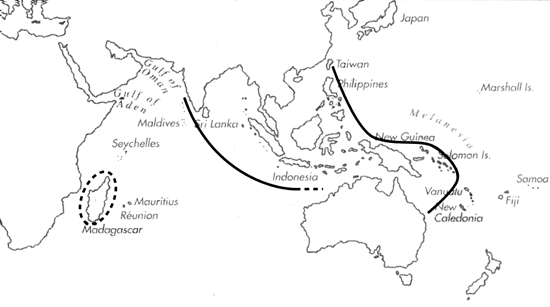Range: India and Sri Lanka to Philippines, Papua New Guinea, Solomon Is., and Queensland; probably Madagascar.
Description: Large and heavy. Last whorl usually ventricosely conical, outline convex at adapical third, straight below. Shoulder subangulate to rounded. Spire low, outline variably concave. Larval shell multispiral, maximum diameter 0.8-0.9 mm. Teleoconch sutural ramps flat to slightly concave, with a few spiral grooves grading to spiral striae in late whorls. Last whorl with distinct or weak spiral grooves on basal third, separating ribbons of varying width.
| Shell Morphometry | ||
|---|---|---|
| L | 80-161 mm | |
| RW | 1.00-3.00 g/mm | |
| (L 80-128 mm) | ||
| RD | 0.59-0.69 | |
| PMD | 0.78-0.86 | |
| RSH | 0.02-0.06 | |
Ground colour cream to tan, variably suffused with orange-brown. Last whorl with spiral rows of brown dots, spots, dashes or narrow bars mostly also aligned in axial rows. Dark markings sometimes alternate with white dashes. Occasionally, narrow orange-brown bands encircle last whorl at various sites. Base, siphonal fasciole and basal part of columella pale orange, often immaculate. Late sutural ramps radially or irregularly maculated with dark brown streaks and a few blotches. Aperture orange or pale brown in subadults, white in adults.
Habitat and Habits: Usually shallow subtidal. In Philippines, egg diameter of about 207 ¬Ķm predicts a minimum pelagic period of about 23 days (Perron & Kohn, 1985).
Discussion: C. suratensis may only be confused with C. betulinus; for comparison, see the Discussion of the latter species.

C. suratensis range map
This section contains verbatim reproductions of the accounts of 316 species of Conus from the Indo-Pacific region, from Manual of the Living Conidae, by RŲckel, Korn and Kohn (1995). They are reproduced with the kind permission of the present publisher, Conchbooks.
All plates and figures referred to in the text are also in RŲckel, Korn & Kohn, 1995. Manual of the Living Conidae Vol. 1: Indo-Pacific Region.
The range maps have been modified so that each species account has it own map, rather than one map that showed the ranges of several species in the original work. This was necessary because each species account is on a separate page on the website and not confined to the order of accounts in the book.